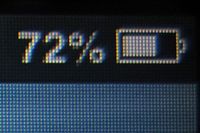Retina display is a branded series of LCDs and OLED displays by Apple Inc. that have a higher pixel density than traditional displays.[1] Apple has registered the term "Retina" as a trademark with regard to computers and mobile devices with the United States Patent and Trademark Office and Canadian Intellectual Property Office.[2][3] The applications were approved in 2012 and 2014 respectively. The Canadian application cited a 2010 application in Jamaica.[citation needed]
The Retina display debuted in 2010 with the iPhone 4 and the iPod Touch (4th Generation), and later the iPad (3rd generation) where each screen pixel of the iPhone 3GS, iPod touch (3rd generation), and iPad 2 was replaced by four smaller pixels, and the user interface scaled up to fill in the extra pixels. Apple calls this mode HiDPI mode. In simpler words, it is one logical pixel that corresponds to four physical pixels. The scale factor is tripled for devices with even higher pixel densities, such as the iPhone 6 Plus and iPhone X.[4] The advantage of this equation is that the CPU "sees" a small portion of the data and calculates the relative positions of each element, and the GPU renders these elements with high quality assets. The goal of Retina displays is to make the text and images being displayed crisper.[5][6][7][8]
The Retina display has since expanded to most Apple product lines, such as Apple Watch, iPhone, iPod Touch, iPad, iPad Mini, iPad Air, iPad Pro, MacBook, MacBook Air, MacBook Pro, iMac, and Apple's computer monitors such as the Studio Display and Pro Display XDR, some of which have never had non-Retina displays.[9] Apple uses various marketing terms to differentiate between its LCD and OLED displays having various resolutions, contrast levels, color reproduction, or refresh rates. It is known as Liquid Retina display for the iPhone XR, iPad Air 4th Generation, iPad Mini 6th Generation, iPad Pro 3rd Generation and later versions,[10] and Retina 4.5K display for the iMac.[11]
Apple's Retina displays do not have a fixed minimum pixel density, but vary depending on and at what distance the user would typically be viewing the screen. Where on smaller devices held or worn closer to the user’s eyes, such as watches and phones, the displays must have very high pixel density for the pixels to be indiscernible to the user, for displays viewed from farther away, such as those of notebook or desktop computers, slightly less pixel density is required in order to achieve the same angular resolution. Later products have had additional improvements, such as an increase in the screen size, contrast ratio, or pixel density. Apple has used names such as Retina HD display, Retina 5K display, Super Retina HD display, Super Retina XDR display, and Liquid Retina display for various iterations.
- ^ Cite error: The named reference
npr info 1was invoked but never defined (see the help page). - ^ United States Patent and Trademark Office. "Latest Status Info – Serial Number 85056807". Trademark Applications and Registrations Retrieval. Retrieved June 19, 2012. Claims priority filing date with respect to prior application in Jamaica.
- ^ Canadian Intellectual Property Office. "Canadian Trade-Mark Data – Application Number 1483982". Canadian Trade-marks Database. Retrieved June 19, 2012. Also cites prior application in Jamaica.
- ^ "The Ultimate Guide To iPhone Resolutions". www.paintcodeapp.com. Retrieved 2021-08-27.
- ^ Jobs, Steve. "Apple iPhone 4 announcement". YouTube. Apple. Archived from the original on 2021-12-15. Retrieved 28 July 2015.
- ^ Nielsen, Jakob. "Serif vs. Sans-Serif Fonts for HD Screens". Nielsen Norman Group. Retrieved 28 July 2015.
- ^ "Apple iPad 3 press release". Apple. Retrieved 28 July 2015.
- ^ Gruber, John. "Pixel Perfect". Daring Fireball. Retrieved 28 July 2015.
- ^ "Apple – Learn about the Retina display". Archived from the original on February 7, 2011. Retrieved June 21, 2010.
- ^ "iPhone X - Technical Specifications — Apple". Apple. Retrieved 22 March 2016.
- ^ "iMac — Tech Specs — Apple". Apple. Retrieved 22 March 2016.

